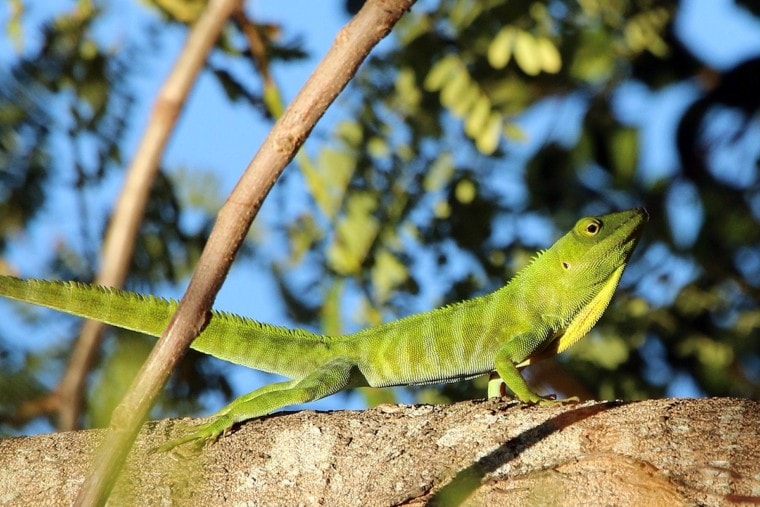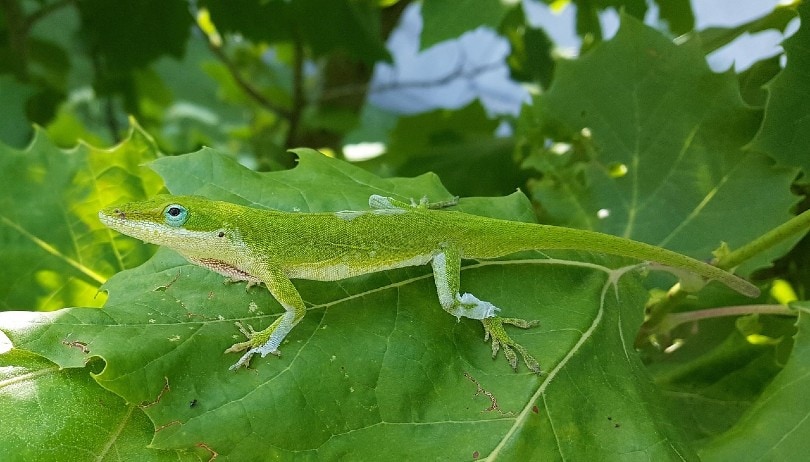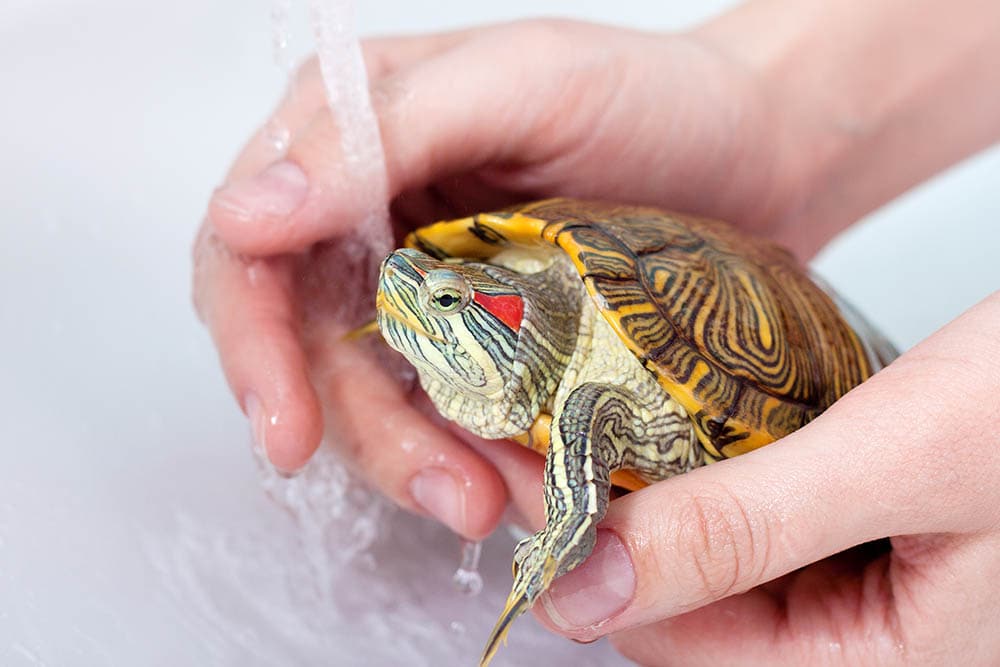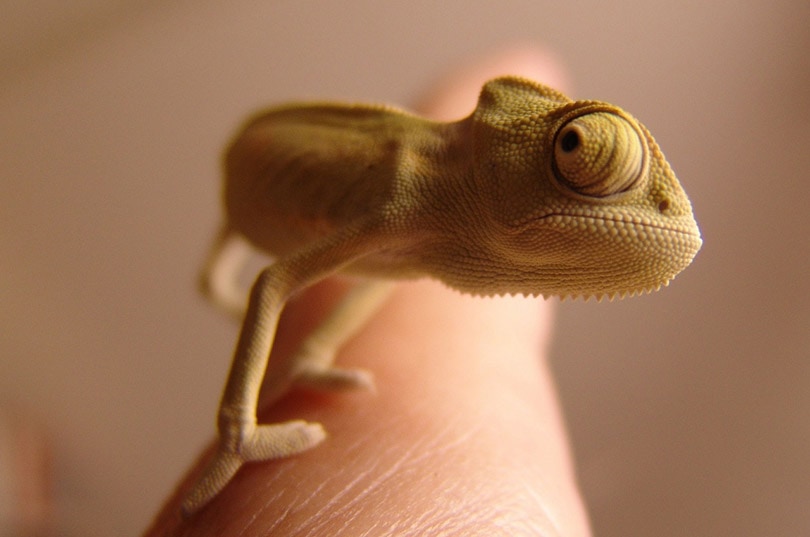
There are more than 400 species of Anole lizards that have been identified, all of which originate in the Caribbean Islands except for one: the Green Anole, which is native to the United States. Of these hundreds of species, only seven or eight are commonly found in the pet trade, the Green Anole being the most popular. Anoles are small tree-dwelling lizards closely related to Iguanas, with most species growing to a maximum of 18 inches long and most being able to change color. They are also venomous, although this venom is largely harmless to humans.
Anoles make great pets for reptile enthusiasts, and besides the popular Green Anole, there are a handful of other Anoles that are commonly kept as pets. Read on for our list of eight Anoles that you can keep as pets!
The 8 Types of Anoles You Can Keep as Pets
1. Bark Anole (Anolis distichus)

| Average adult length: | 3 – 5 inches |
| Origin: | Haiti, Dominican Republic |
| Color form: | Grey, brown, green, yellow-banded tails |
Bark Anoles are one of the smallest Anoles kept as pets, and never reach more than 5 inches in length. They have a brown-grey mottled skin, after which they are named, that enables them to blend into the tree bark of their natural habitat, with yellow banding on their tails. They are exceedingly fast little lizards that can dash around large tree trunks before you get a chance to get a good look at them. While they are native to the Caribbean Islands, they have established a fairly large population in Florida and are popular in the pet trade.
2. Bearded Anole (Anolis pogus)
| Average adult length: | 4 – 7 inches |
| Origin: | Western Cuba |
| Color form: | Light brown |
The Bearded Anole has characteristically long legs to help it navigate large trees and a large dewlap that is lined with small spikes, giving them their name. These Anoles are challenging to keep in captivity, although if well-cared for, they can live for up to 10 years. Like many other Anoles, they can change color to escape from predators. They have a “third eye,” known as the parietal eye, that can respond to light and may help in the detection of predators too.
3. Big-Headed Anole (Anolis cybotes)

| Average adult length: | 5 – 8 inches |
| Origin: | Haiti, Dominican Republic |
| Color form: | Brown-grey |
The Big-Headed Anole, named for the disproportionately large head of the males, is native to the Caribbean Islands but has an established population in southern Florida too. They have a flap of skin running down their backs that they can raise at will like a sail, a short snout, and a pale yellow extendable throat fan. Their bodies are typically brown to grey in color, although they sometimes have a green stripe running down the sides of their bodies.
4. Brown Anole (Anolis sagrei)

| Average adult length: | 5 – 9 inches |
| Origin: | Cuba |
| Color form: | Brown with white patterning |
The Brown Anole is inexpensive and easy to care for as a pet, making them one of the most popular varieties for beginner reptile enthusiasts. They are typically brown or grey in color, with white or yellow patterning on their backs, and males have an orange or red throat fan or dewlap with a white edge. They are less arboreal than most other Anole species, preferring the ground or low vegetation over trees, although they thrive in almost any habitat and can be found in abundance in urban areas of Florida, where they were introduced from the Caribbean decades ago.
5. Common Green Anole (Anolis carolinensis)

| Average adult length: | 6 – 8 inches |
| Origin: | Southeastern United States |
| Color form: | Bright green |
The Green Anole is the only Anole species native to the United States and is one of the most common species in the pet trade. They are popular among beginner reptile enthusiasts because they are easy to care for, fairly small, and inexpensive. They are sometimes called American chameleons because they can change from bright green to brown in seconds, but they are not true chameleons at all. Males have a bright red or pink dewlap that they flash when they feel threatened, and they can be highly territorial at times.
6. Crested Anole (Anolis cristatellus)

| Average adult length: | 5 – 8 inches |
| Origin: | Puerto Rico |
| Color form: | Olive brown, green |
The Crested Anole, also commonly referred to as the Puerto Rican Anole became they are native to this Caribbean island, is named for the large crest that both males and females have on the backs of their necks and that males occasionally have on their tails. They have established a fairly large population in Florida and are growing in popularity in the pet trade, although they are extremely skittish and do not enjoy handling.
7. Cuban Knight Anole (Anolis equestris)

| Average adult length: | 15 – 20 inches |
| Origin: | Cuba |
| Color form: | Bright green |
The largest of all Anoles, the Cuban Knight Anole can reach up to 20 inches long in adulthood. They are typically bright green in color but can quickly change to a dull brown when needed. They have a yellow or white stripe that runs from their eye and extends over their shoulder. They originated in Cuba but have a fairly large population in Florida too, although they are not as commonly found as pets as some other Anole species.
8. Jamaican Anole (Anolis garmani)

| Average adult length: | 8 – 11 inches |
| Origin: | Jamaica |
| Color form: | Bright green with light spots or stripes |
Also known as the Giant Anole or Graham’s Anole, the Jamaican Anole are most recognizable by the crest of small sharp ridges that run down their backs. They are typically bright green with small yellow or white spots or stripes but can change to brown or black rapidly if needed. They have characteristic orange and green dewlaps, with a yellow border that distinguishes them from other Jamaican Anole species, and a distinct dorsal crest.
Conclusion
While there are hundreds of Anole species in existence, only seven or eight are commonly kept as pets, with the Green Anole being the most popular. Anoles are easy to care for and incredibly fascinating to watch and make wonderful reptile pets for beginners.
- Related Read: Do Green Anoles Make Good Pets?
Featured Image Credit: Charles J. Sharp, Wikimedia Commons CC 4.0 International (Jamaican giant anole (Anolis garmani))








